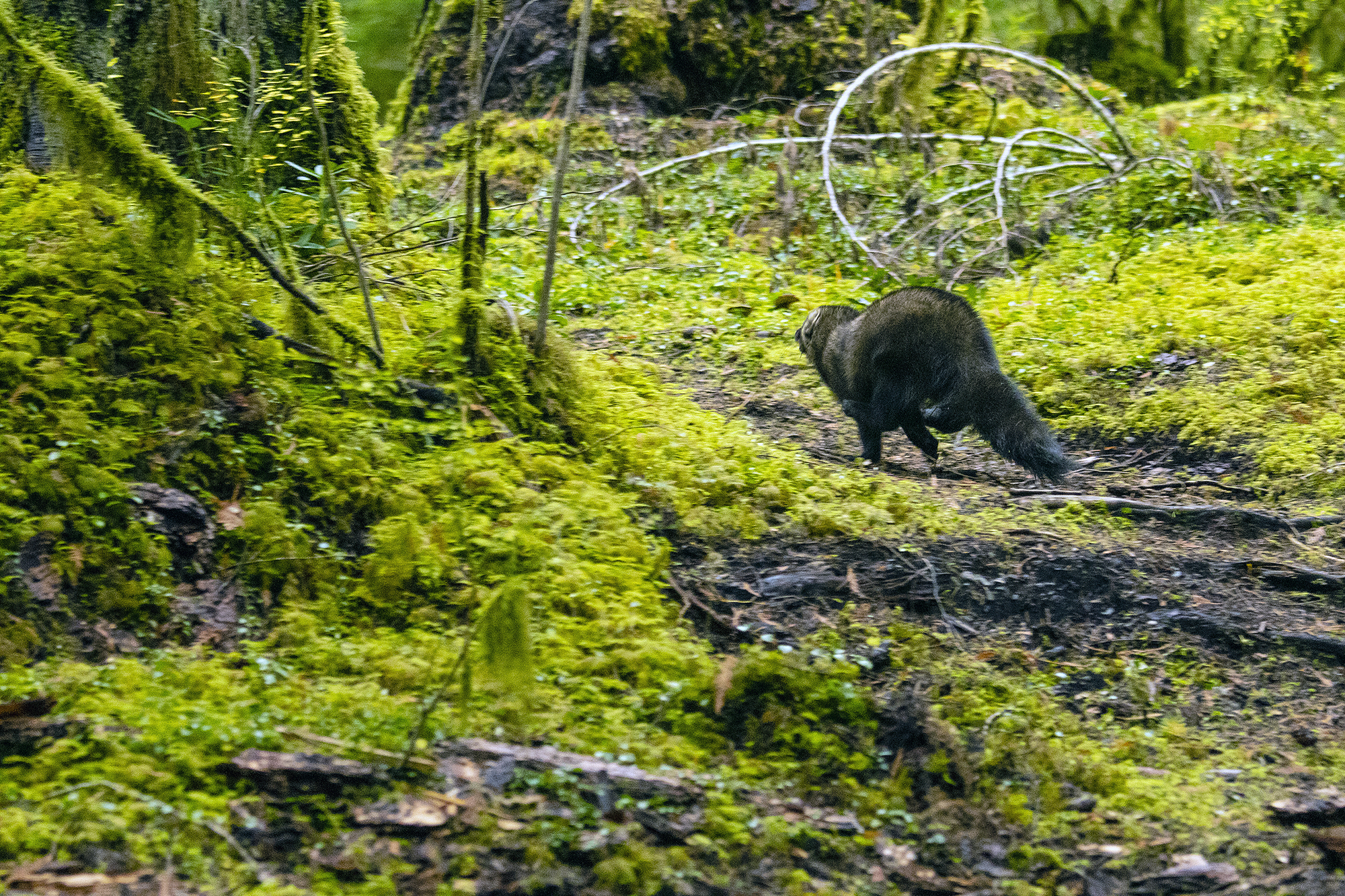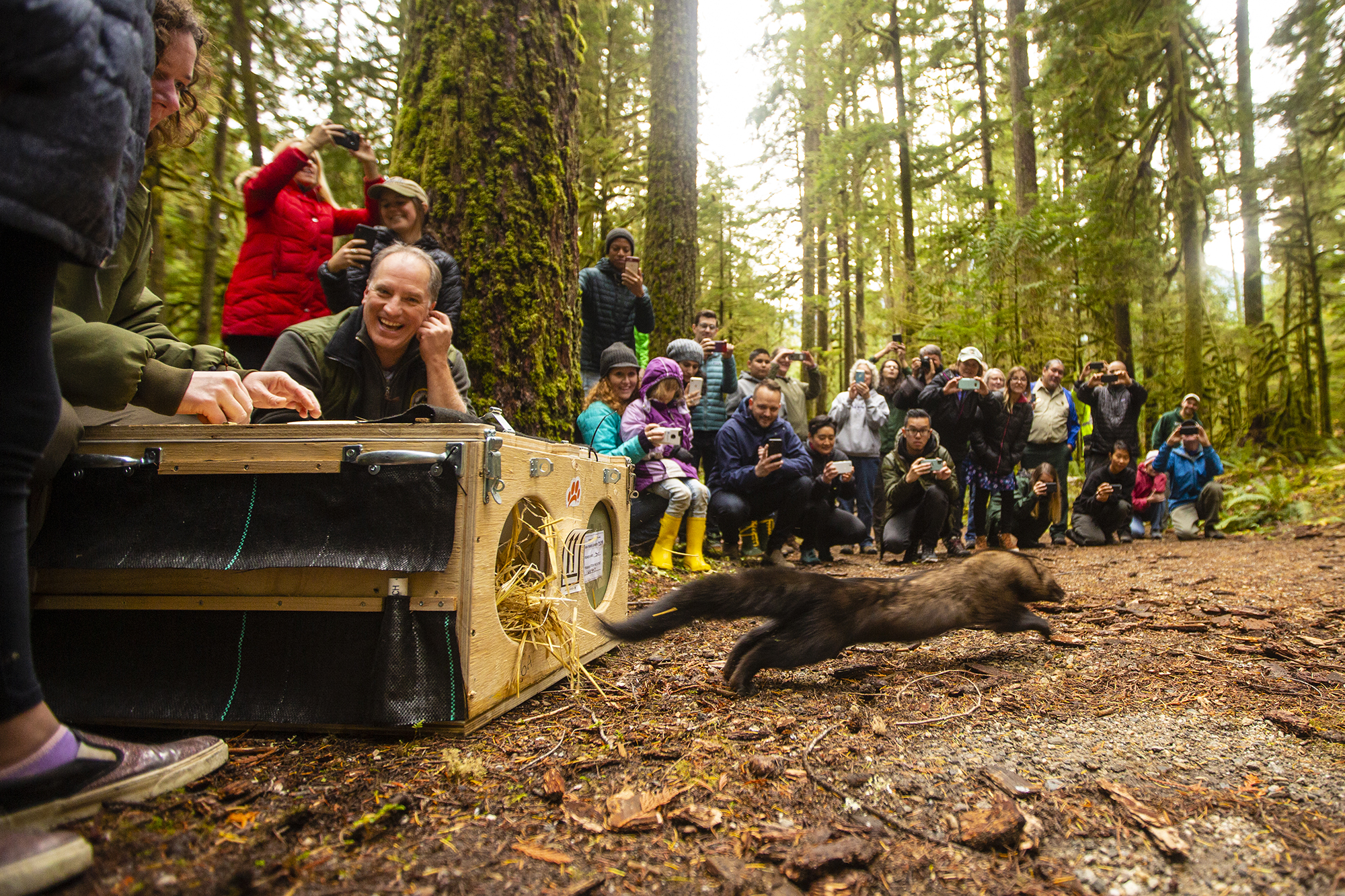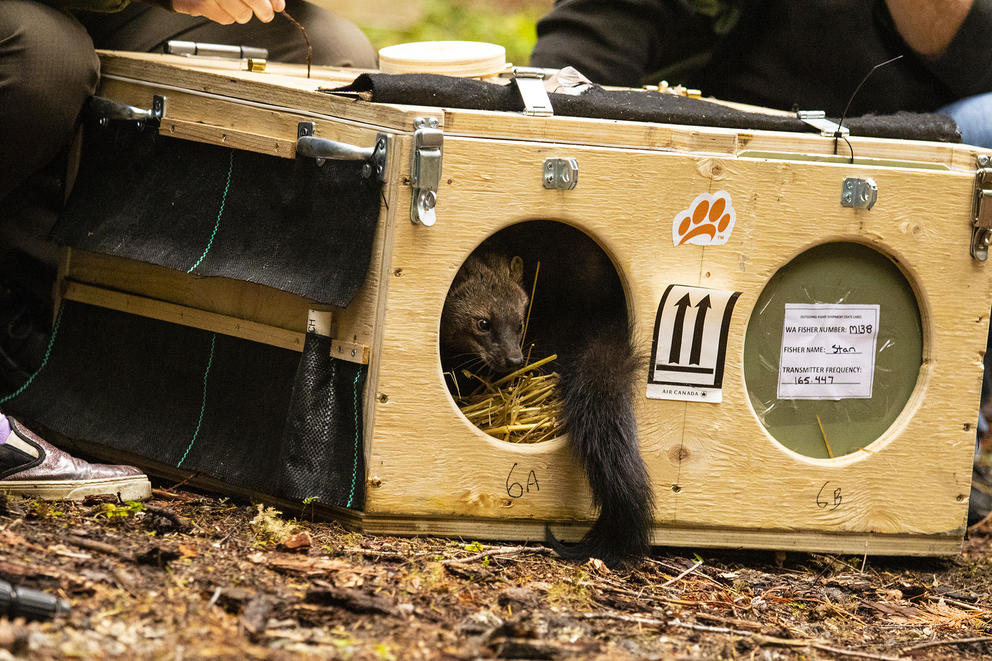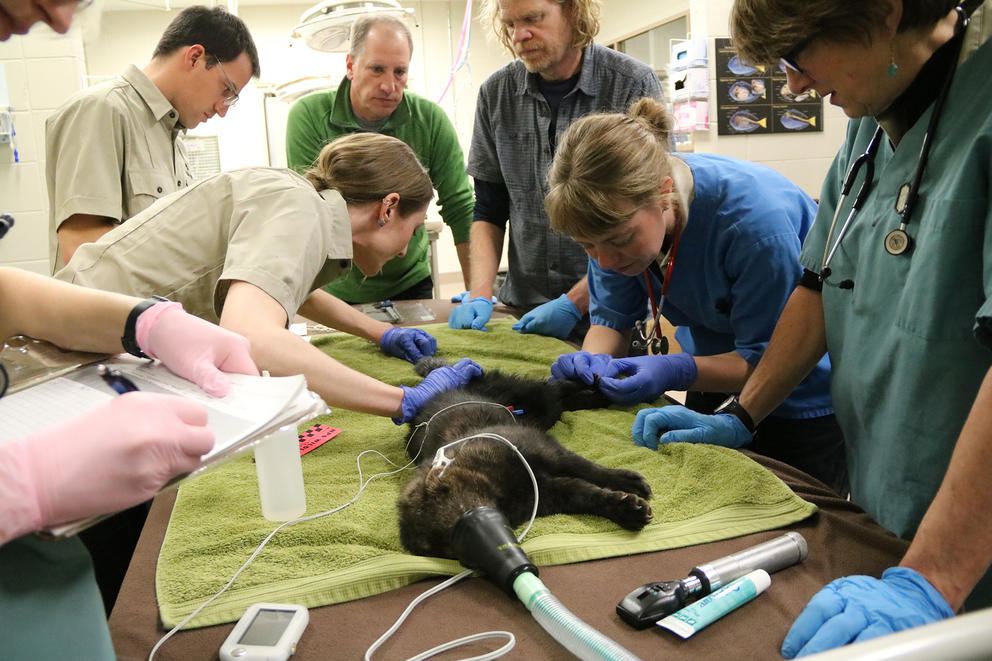Principal co-investigator Dr. Jeff Lewis, a conservation biologist with the Washington Department of Fish and Wildlife, and colleagues set minimum population targets based on successful reintroduction programs elsewhere; programs with at least 80 fishers tend to self-sustain.
While the mustelid is obscure to many, its presence offers benefits to the ecosystems it once roamed in.
“They’re so secretive. Even where they are, people don't know about them,” Lewis says. “And they're at least as cool as a wolverine! At least!"
“It's nearly impossible to fully grasp each and every subtle consequence of their presence,” says Shannon Kachel, a Panthera conservation scientist who was present at a release in 2017. “Every single little interaction ripples through the food web in ways that are hard to predict, but they all add up.”
The release on Friday occurred within a section of the campground reserved for the Nisqually Indian Tribe.
“The fact that the Nisqually Tribe is allowing us to release a fisher into that area is an incredibly generous and powerful gesture on their part, of honoring the restoration and the return of the species to the landscape,” says Dr. Tara Chestnut, an ecologist at Mount Rainier and principal co-investigator. Calls to Nisqually representatives were not returned.

For Lewis, Chestnut and their collaborators, the project has been all-consuming. But the promise of an intact ecosystem complete with carnivores that manage other species’ population levels drove them to the finish line, especially in the wake of recent rising animal death tolls around the world.
“All of those things I think just emotionally take a toll on all of us,” Chestnut says. “To reach this milestone, it sheds a light of positivity on some of the conservation successes that we’re having, and that it’s not all gloom and doom.”
For many involved, the fisher release project has marked milestones in their personal lives.
“My son released the first fisher back into the Cascades and he's been sort of an ad hoc part of our team ever since,” says Dr. Jason Ransom, a National Park Service senior wildlife biologist and principal co-investigator. “He was pretty small when we started, and now he can carry the box.”
With this release and possibly one or two more by the end of the month, the release phase will have wound down. The team hopes to release seven or eight more in the North Cascades in January, but there are no releases planned after that, for any of the sites. Lewis says monitoring for the project will likely continue into 2021.
The fisher project begins
Slightly smaller than a Maine Coon, with a face like an elongated teddy bear and a musk Lewis describes as “tangy, rancid vanilla,” fishers closely resemble other weasel family members like martens and minks. Their toughness rivals their cousin, the wolverine: They are one of the few animals that can successfully prey upon porcupines.
Fishers historically thrived in low- to mid-elevation forests in Washington’s western half, northeastern corner and in pockets of the southeast, where they denned in craggy old-growth trees. But English settlers found big money in their pelts. A commercial trapping ban in 1933 came too late, and logging and development carved up much of the forests remaining fishers needed to reproduce.
"We didn’t have any reliable detections of wild fishers since 1969,” says Lewis, who has studied the animal for over two decades. “There was one detected at Fort Lewis, but that one had escaped from Northwest Trek Wildlife Park, so that one didn’t really count."
Even if some fishers remained undetected, scientists concluded they wouldn’t come back to full strength without a helping hand.
By 1998, the state listed fishers as endangered. Conversations among the Department of Fish and Wildlife, the National Park Service, Conservation Northwest and other groups put recovery in motion. By 2006, they developed a plan using Washington’s three national parks. Wild fishers would be procured by trappers in British Columbia, where fishers were doing well, and released in Washington.
The precise extent of the role fishers play in Washington forests is unclear, but Ransom points to activities like spreading berry seeds through digestion and eating small mammals, with younger fishers becoming prey for larger animals. And most ecologists agree that ecosystems with more biodiversity are more resilient to stressors: When multiple animals fill similar roles, food webs have a better chance of surviving the havoc of fires, floods, disease, development and other changes.
“Maybe [ecosystems are] more resilient to climate change, maybe they're more resilient to other natural disasters — that's probably all true. But the biggest reason [for the project] was these animals disappeared on our watch,” Lewis says. “It certainly wasn't anyone’s intention for them to disappear, but … they were gone before we knew anything about how to manage [fishers].”
The team first released fishers in Olympic National Park, from 2008 through 2010. A South Cascades (Rainier) project started in the fall of 2015, and in the North Cascades in fall 2018.
Animals are released outfitted with VHF radio-transmitter chips, which last up to two years. Long-term monitoring relies on hair snares and camera traps.
Those latter releases happened despite huge barriers. Wildfires broke out over B.C. fisher habitat in 2017 and 2018. Without knowing how many fishers were left, the B.C. government paused the project. With the help of wildlife officials in Alberta, a commercial air carrier and the Calgary Zoo, the team found a way to bring more fishers from that province to America by plane. “Everything worked out but there's one challenge after another,” Ransom says.
The process puts animals through considerable stress: They’re caught, transported to a vet, shipped to Washington, driven out to the forest and left to find habitat, food and mates in a foreign environment. This is where their signature toughness can be a benefit.
“When you think about all they go through, we’re asking a whole lot of them and they just do it,” Lewis says. “And they can get along with three legs and just one eye and all kinds of broken bones, and they just don't let that stop them.”
From left to right: Hannah Edwards and Jose Postigo of Calgary Zoo, Dr. Jeff Lewis of WDFW, Dave Werntz of Conservation Northwest, and Emma Vaasjo and Sandie Black of Calgary Zoo perform a health exam and collect morphology data on an anesthetized fisher before it is flown to Washington for release. (Dr. Jason Ransom/National Park Service.)
Human handlers require toughness as well: They drive long hours with the fishers chirping away in specially made transport boxes; slog through permit applications; coordinate dozens of volunteers and employees across local, state, tribal, federal and international agencies; find and train trappers they can trust to procure animals in Canada; trudge through deep snow to retrieve bodies of dead fishers; fly planes over the parks to track fishers’ radio transmitters; and much more. Animals are in captivity for less than a month — averaging 21 days — and the journey from Canada to freedom in U.S. forests takes only days.
Luckily, Lewis thinks charismatic fishers are ideal candidates for restoration: transplantable animals exist, as does good habitat.
“There’s so much passion and interest and care that goes into these animals,” he says.
The possibility of future fishers
With many follow-up monitoring surveys ahead, scientists say it will be years before they can declare fishers restored to the state.
Getting good survey data is difficult. It’s hard to find fishers by sight, so surveyors need good conditions to fly planes and trek through the woods to ping the short-lived radio transmitters.

“That really limits our ability to find them as easily, so we’ve relied on reports from other people,” Chestnut says. Continued monitoring at Rainier will include camera traps and hair snares.
For the population to be restored, the team hopes to confirm consistent reproduction with good genetic diversity across multiple generations. Fishers live about 10 years in the wild. The recovery plan estimates a survival rate of at least 50% annually for released animals would let populations achieve that.
In the Olympics, there’s evidence that populations are reproducing and even more widely distributed than expected, though not as densely as is ideal. Lewis says that they’ve ventured out from the interior of the park as far as the Makah and Quinault reservations.
Chestnut says initial observations in the South Cascades are also positive. The annual survival rate there has been in most cases higher than 50%, and in some years as high as 80%. They’ve also seen and photographed at least one kit in both of the past two years, and suspect there are others.
Fisher reintroductions elsewhere have been successful. Vermont released fishers between 1959 and 1967, and were able to reopen a trapping season in 1974.
It's about more than bringing back fishers
Positive results from the project could inform future plans to restore other missing carnivores.
“We’ve taken a baby step here with fishers, and wolves are back on their own … and restoring bears could be really good in a number of ways if enough people support it and get behind it,” Lewis says. “[Fisher reintroduction] probably makes it a little easier to do that [now].”
But fishers are perhaps the least controversial of Washington’s missing carnivore contingent.
“This is one of the few carnivores that the state and public have unanimously rallied around to bring back to our landscape,” says Robb Krehbiel, Northwest representative of Defenders of Wildlife, who saw a release in 2019. “When we deal [with grizzlies and wolves], there’s normally a lot of division about the roles those creatures play on the landscape.”
“The grizzlies are a different situation, in that no one [is] worried about having a run-in with a fisher,” Lewis says. “[But] bringing fishers has enabled us to develop friendships and alliances: That will help us in the future.”
Update: This article was updated at 11:04 a.m. on Jan. 13, 2020, to correct the spelling of David Moskowitz's name in photo captions.





